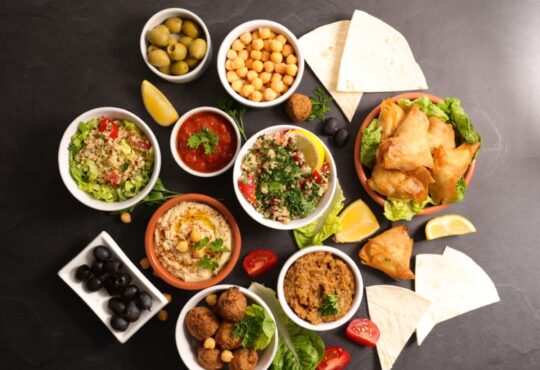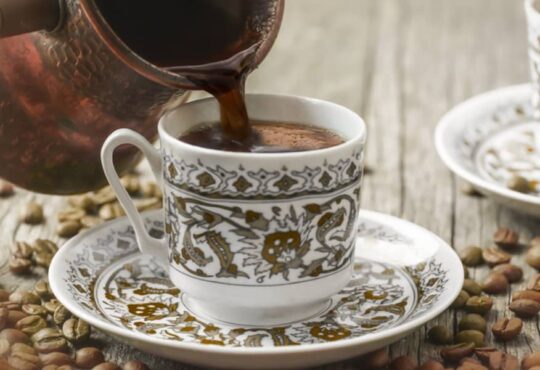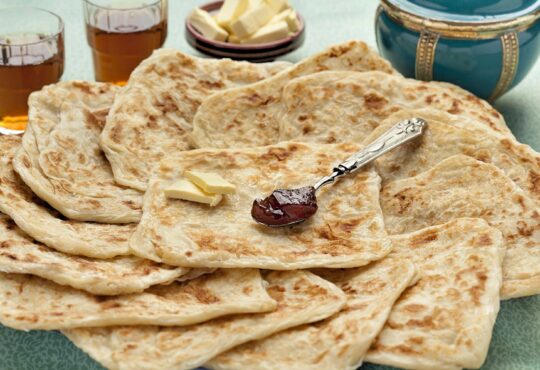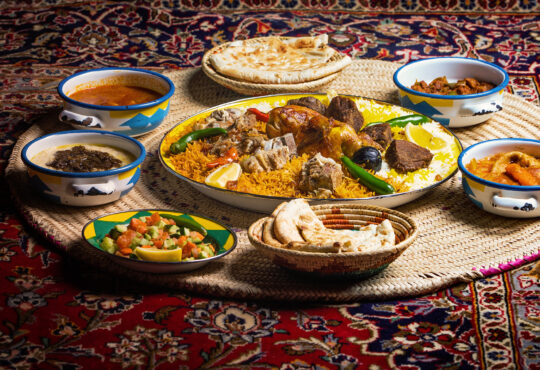657
If you’re traveling to Iran for vacation or business, know that you’re in for a gastronomical Persian treat. Persian food ranks high on lists of the world’s best cuisines and is well worth exploring.
You won’t be disappointed with the incredible variety, flavorful seasoning, and innovative ingredient combinations that await you.
Not heading to Iran anytime soon? Then pick up our favorite Persian cookbook and indulge in the flavors of Iran in the comfort of your own home.
The following slides feature 30 famous Persian foods to seek out in restaurants and in Iranian homes during your visit.
FOOD-RELATED CONTENT
Persian Steamed Rice
This dish is a must when visiting Iran. It’s a popular staple dish that can be served with anything.
Persian steamed rice is usually made using white Basmati rice, a long-grain type of rice. Rice is essential in Persian cuisine so is the process of making the perfect rice.
The rice cooking process in Iran is similar to the Chinese and Indian ways, However, Persian rice should be cooked so that the grains are soft from the outside but still firm from the inside. Persian rice is usually decorated with Saffron for an extra flavor and color.
Tahdig
Tahdig is another way of serving Persian rice in Iran. Tahdig literally means “bottom of the pot” in Persian and it refers to the pan-fried Persian rice that is soft on the inside with a perfectly crispy and golden crust on the bottom of the pan.
Meygoo polo
Meygoo polo is a simple Persian dish made of rice and shrimp.
The rice is cooked and completely drained of its water, while the shrimps are usually sautéed or boiled separately along with onions, garlic, and spices.
Ash-e doogh
Ash-e doogh, also known as “yogurt soup”, originates from the Azeri region of northwest Iran and is one of the traditional soups of Urmia and Ardabil.
It is a typical dish found in many regions and cultures within West Asia, including Iran, Azerbaijan, and Turkey.
Zereshk Polo ba Morgh
Zereshk Polo ba Morgh is a Persian classic made with Zereshk (barberries), Morgh (chicken), and Polo (Persian rice).
This is one of the mixed rice dishes that you will find at small casual get-togethers, as well as larger Persian dinner parties, weddings, and most festive celebrations and holidays.
Sometimes this dish is served with Soup é Morgh é Zaferani, or Soup é Jo, and a simple salad.
Shirazi salad
Shirazi salad is a Persian salad that originated in Shiraz city in southern Iran. It is a traditional fresh salad made of cumber and tomato.
Drizzles of olive oil and lemon add an extra flavor to the salad and it goes very well with many Persian dishes.
Sholezard
Sholezard is a Persian traditional saffron rice pudding dessert. It is traditionally served on the occasion of festivals such as Ramazan.
Khoresh-e Ghormeh Sabzi
Khoresh-e Ghormeh Sabzi is a prevalent dish in Iran and is known as one of the most prominent dishes in Persian culinary heritage.
Khoresh-e Ghormeh Sabzi is often considered the national dish of Iran. The secret to this special Persian dish is the fresh herbs that release all the tastiness into the chunks of lamb meat.
In addition to the herbs, the flavorful Persian stew includes Omani dried limes to provide an exquisite sour aroma.
Kabab Koobideh
Kabab koobideh also called Kobida is a Persian meat kabab made from ground lamb or beef, often mixed with ground pepper and chopped onions.
A popular Persian dish made of Kabab Koobideh is Chelo Kebab Koobideh which literally means “White Rice with Kabab”.
Khoresh-e Gheimeh
Khoresh Gheimeh or Qheimeh Polo is a Persian stew consisting of diced mutton, tomatoes, split peas, onion, and dried lime, garnished with golden saffron potatoes.
The stew is usually served with Persian white rice and that’s why it’s called Qheimeh Polo (with Polo means Rice in Persian).
Baghali Polow ba Mahiche is one of the most popular dishes in Iran and is usually served at parties such as wedding ceremonies.
The combination of rice with dills and broad beans is called Baghali Polow, and the fork-tender lamb shanks which are served beside the rice are called Mahiche.
These two parts served together make up a sublime tasty Persian dish called Baghali Polo ba Mahiche.
Tahchin Morgh
Tahchin is a Persian rice cake primarily consisting of rice, yogurt, saffron, and eggs. Some versions of the dish are more elaborate, folding in chicken fillets, vegetables, fish, or red meat.
The flavorful Persian rice cake is packed with aromas and perfect for weekend dinners.
Ash-e Jow is a healthy Persian soup that is made of barley, lentils, chickpeas, and beans (white beans or small red kidney beans).
This delicious Persian dish is considered among Persians as an ideal food choice for winter when you need all the strength and nutrition ingredients.
Kuku Sabzi
Kuku Sabzi is the Persian version of the Italian frittata or the Arab Eggah but with less egg and more vegetables.
The base of Kuku Sabzi is herbs and herbs namely chives (tareh), cilantro (geshneez) and dill (shevid) are used.
Naz Khatun is an authentic Persian vegetable condiment that originated in the city of Behshahr.
It is prepared with fire-roasted or oven-roasted eggplants, a rather large amount of herbs, and the unusual verjuice, a zesty drink made from unripe grapes.
Faloodeh
Faloodeh or Paloodeh is a traditional Persian cold dessert similar to a sorbet.
It consists of thin vermicelli-sized noodles made from starch in a semi-frozen syrup containing sugar and rose water. Faloodeh is often served with lime juice and sometimes ground pistachios.
Kabab Torsh
Kabab Torsh is a tasty kabab dish that originated in the north of Iran. Kabab Torsh simply translates to “sour kabab”.
To make the Kabab Torsh, the meat is meat should be well-marinated with pomegranate molasses and other local Persian spices.
The meat is skewered and then grilled, and the whole dish is served with grilled vegetables and rice.
Halva Ardeh
Halva Ardeh is another form of traditional halva recipe commonly made during celebrations as well as other occasions.
Halva is widely spread in the middle east. It’s a sweet, dense paste that is usually prepared with a base of sugar and ground sesame or tahini.
Khoresh mas is a Persian cold side dish from Isfahan (City in central Iran). Khoresh is made of an unusual combination of yogurt, eggs, sugar, saffron, and lamb neck fillet.
Vegetarians can always find a version of this unique dish without meat but the authentic Khoresh Mas is the one that has meat in it.
Nan-e berenji
Naan Berenji is a Persian rice-flour cookie originating from Kermanshah. They are usually white but sometimes tinted yellow.
These irresistible cookies are formed into flat, round shapes, then flavored with cardamom, and garnished with poppy seeds.
Zeytoon Parvardeh
Zeytoon Parvardeh is basically olives covered in a paste made of fresh herbs, walnuts, garlic, pomegranate molasses, and fresh pomegranate seeds.
This simple combination is a popular cold appetizer and it’s usually served with Lavash bread.
Ranginak is a no-bake Persian dessert that’s packed with dates (preferably Mejdoul dates (affiliate)) and walnuts.
The delicious dessert is made by stuffing the dates with walnuts before adding a mixture of butter and flour infused with cardamom and cinnamon.
Ranginak is especially popular during Ramadan, the fasting month when dates are abundantly consumed.
Nan-e Barbari
Barbari bread is a type of yeast-leavened Persian flatbread and it’s one of the most flavorful flatbreads in Iran.
Nan-e Barbari is formed into an oval or round shape and then glazed with a mixture of flour oil. The bread is commonly topped with sesame or black caraway seeds.
The bread pairs perfectly with a simple block of cheese and some walnuts.
Gheymeh Nesar is a Persian stew made with meat, nuts, and barberries. The dish originated in Qazvin, one of the central provinces of Iran, and is rarely served in restaurants in other parts of the country.
Gheymeh Nesar consists of diced meat such as beef or lamb that is braised with onions and spices, as well as steamed rice and a flavorful combination of various ingredients such as slivered pistachios and almonds, barberries, and sliced orange peel.
Mast-o Khiar
Mast-o-khiar is a scrumptious classic Persian salad of cool cucumbers with creamy yogurt and infused with fragrant herbs.
Mast-o khiar is an everyday side that pairs very well with many Persian dishes.
Morasa Polow
Morasa Polo is a Persian rice dish mixed with chopped chicken and lots of saffron.
The name, flavor, and colors of Morasa Polow dish come from its garnishing ingredients, barberries, raisins, carrots, orange peel, almonds, and pistachios.
Qottab or Ghotab is a traditional Persian almond and walnut-filled crescent pastry that is infused with cardamom and cinnamon flavors.
Ghotab sweets are made by wrapping almonds or walnut with soft dough and deep-frying it until golden. To add a kick of sweetness, the pastries are dusted with powdered sugar.
Abgoosht
Abgoosht, also called Dizi which refers to the stoneware cooked in, is an Iranian stew made with mainly meat, potato, and chickpeas.
For a delicious Abgoosht, the meat should be well cooked in a clay pot (Dizi pot) with potato, chickpeas, tomato, onions, and spices until the flavors are all mixed together.
The traditional Abgoosht is commonly served in a clay pot with Persian homemade bread.
Ash-e Reshteh
Ash-e Reshteh is a great vegetarian dish. It’s a traditional Persian noodle soup with a captivating taste that comes from the aromatic combination of herbs, and beans.
Ash-e Reshteh is perhaps the most popular Persian soup during festive times in Iran, including the Persian new year.
Kaleh Pacheh
Kaleh Pacheh is one of the oldest dishes in Persian cuisine. Dating back to 2000 BC, Kale Pacha is a traditional Iranian dish that consists of cooking lamb’s head hooves meat until tender.
When it comes to Kaleh Pacheh you either love it or hate it. However, in Iran, most people love having it for breakfast after they spent hours cooking it at night.
Chelo Kabab
When you visit Iran, you will be recommended to try several dishes and each one of them will be referred to as the national dish of the country.
Iranian love their dishes the same way. At least a few of them. Both Chelo Kabab and Ghormeh sabzi dishes are competing over the Iranian national dish spot.
Alcohol is strictly forbidden in Iran except for the Armenian Christians that are allowed to produce and drink their own alcohol.
There are no bars in Iran or even reel bear. However, they have many non-alcoholic drinks that do the job of tasting like Alcohol.
Drinking in public is legally punishable as well as bringing alcohol into the country.
Similar to Alcohol, pork meat cannot be found in Iran. Trading pork is illegal in the country therefore it’s not available in restaurants and food places in Iran.
I have no idea whether bringing pork into the country is legal or not but I would not recommend it even for personal use.





